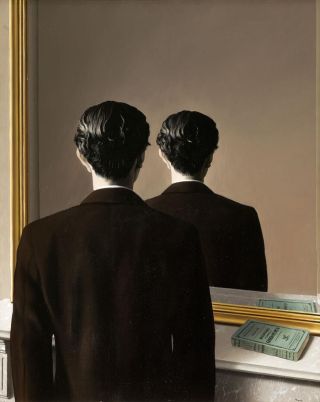Deception
Why Mirrors May Not Show Our "Real" Selves
What we call the self is made up of at least 3 perspectives.
Posted March 7, 2024 Reviewed by Gary Drevitch
Key points
- We are not satisfied with mirrors because they do not show our ‘real’ selves.
- There is no true self, only the result of an ongoing negotiation with ourselves.
- New technologies increasingly affect our perception of the self.

Mirrors were better in the past. So said my father-in-law, who became 93 years old. In his last years, he grew disenchanted with the reflection staring back at him each morning.
Many people think that the image they see of themselves in the mirror is not accurate; they look too old and ugly. The same goes for photographs. Susan Sontag notes: "Many people are anxious when they’re about to be photographed: not because they fear … being violated but because they fear the camera’s disapproval. People want the idealized image: a photograph of themselves looking their best. They feel rebuked when the camera doesn’t return an image of themselves as more attractive than they really are."
Thus, there is a conflict between what the mirror or photo shows and our perception of ourselves. We often cherish photographs of ourselves when we were younger, to encourage self-deception when our current reflection does not match our vain imagination. Or we manipulate a photo we have taken with our phone before publishing it on social media.
In fact, mirrors were not at all better in the past. Mirrors, as we are used to them, are historically a new phenomenon and became commonplace in homes just over a century ago. So how did people create their self-image before mirrors? There are two other ways to gain knowledge about ourselves. One is through the perceptions that other people have of us. Talking to those close to us allows us to see ourselves from the outside: A friend is a mirror for our inner self. We see ourselves through others' perceptions of us and through the inner (and outer) qualities that others attribute to us. Sometimes people we don't know can be a better source because they can see us from an unexpected perspective. (We may also have duped those close to us with our own self-image.)
Another way to gain knowledge about ourselves is to reflect on how we experience our body and our inner world. We try to understand our thoughts, memories, feelings, and actions and compare them with what we experience from other people and with how we remember being when we were younger.
It is a common belief that deep inside us is our 'true' self. We strive to be 'authentic', but what we call the self is a combination of at least three perspectives: the appearance as seen in the mirror, how we reflect ourselves through others, and the perceived inner world. These three ways of looking at the self sometimes conflict with each other. The question is how we combine them into a unified 'I' – or whether it is even possible to combine them into a single entity. The Oracle of Dephi's maxim was 'Know thyself'. This may not be possible because there is no hard core that constitutes your true self. As Danish poet Henrik Nordbrandt writes, "whatever rivers we reflect in, we see ourselves only when we have turned our backs.”
A more appropriate picture is that the self is the result of an ongoing negotiation with ourselves in which we weigh different desires against each other, but where the expectations of the people around us and the prevailing culture also contribute. We are constantly constructing our selves. And we are adept at deceiving ourselves in this kind of negotiation.
Facebook image: Antonioguillem/Adobe Stock


